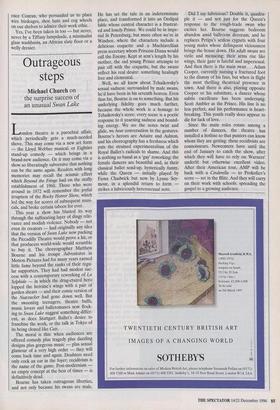Cliché corner
Leslie Geddes-Brown on design ideas done to death over the decades In the Forties, every suburban semi was supposed to have a flight of three pottery ducks on its sitting-room wall. It became a cartoonist's cliché. The Fifties cliché was furniture with tiny splayed legs ending in little balls (they would have pierced the carpet otherwise), followed by stripped pine (Sixties), psychedelic bean bags (Seventies) and, in the Eighties, oversized curtains which flowed across the floor like lava.
The Nineties have now had time to develop their own crop of clichés. For a quick run-down on good ideas done to death, scrutinise the advertisements for fit- ted kitchens. First there is the Aga — I have nothing against them, I have one myself — but they are an essential part of the poseur's cuisine except in urban kitchens where a wildly expensive French cooker studded with knobs of steel or brass like a warship's boiler is de rigueur. Over the hotplates, in a position carefully designed to attract the most dust, steam and grease, you will find, slightly above your reach, a hanging garden of dried — very dried — herbs along with esoteric pieces of culinary equipment, a chinois per- haps or a paella pan. This kitchen will also have a ceramic butler's sink, an immovable butcher's block for jointing vast carcasses and an array of graduated copper pans. The owners buy all their food ready-made and heat it in a microwave concealed in a cupboard.
Along with the herbs, larding needles and gaufrette cutters there may well be a nest of hanging wicker baskets, French breadboards (so much more chic than English ones) and wooden trugs. These are likely to spread into the conservatory (another Eighties cliché but, I hope, dis- tinctly passé today), the hall, mud room or
'I think I'm being stalked.'
styled potting shed where black plastic pots, orange baling twine and crumpled gardening gloves must never appear. Pots should be terracotta, the twine biodegrad- able raffia and gardening gloves white, American goat skin which gently softens the hands with integral lanolin but can't cope with mud.
Straw hats, battered, decked with rib- bons, or worn-out ties of upmarket clubs like the Garrick and I Zingari, amusing fake roses or deliberately vulgar costume jewellery are the cliché par excellence. They must hang by a garden door and, ostensi- bly, belong to all members of the family or visiting friends. There's Rupert's roll-up Panama, Cosima's sun bonnet bought at the village fête and Jolyon's faded Henley boater, all bringing back memories of sum- mer when the Pimms was easy. One more hat must be flung, wittily, casually and not quite accurately, over a marble bust of a nymph. Old hat today, this joke was actual- ly quite funny in 1980.
Another exercise in old-hattery is to style your bedroom with its own diaphanous mosquito net. Perfectly understandable in, say, Kinshasa, but less so in Cheltenham and York, where the malarial mosquito is not a problem. But it has been a constant cliché ever since one of the Vogue fashion editors discovered (fashion editors never just go to a shop and buy things) a real mosquito net on a tropical shoot and hung it in her loft bedroom in New York's SoHo.
The perfect designer cliché is a state- ment in pointlessness. Dried herbs which are thrown into the pot, mosquito nets which thwart mosquitoes, trugs which transport vegetables are acceptable. But what about those dear little tartan bows which appear above sweet silhouettes or needlework portraits of dogs? What, indeed, of the current fad of littering your walls with empty picture frames? Are we intended to admire the frame itself as a work of art or the visual joke of the clever decorator? John Fowler, perpetrator of many of these clichés, though the ideas were original in his day, liked to hang pic- tures over mirrors and landed us with banks of 'amusing' cushions painted with pugs and embroidered with deadpan mot- tos. The cushions must be flung aside before you can sit comfortably.
I think he also invented the dining-room chair dressed up in a summer frock with an elaborate bow on its back and, in the same pseudo-economic mode, the round bedside table which is merely a circular piece of hardwood disguised by a swoosh of charm- ing material. 'Pseudo' because the frocks and swooshes were made up in fabric that cost an indrawn breath. His influence also lurks among those who do awfully clever things with bits of fake leopard and tiger skin.
I must, however, acquit Fowler of other Nineties' clichés like the driftwood mirror frame or the candle in a mussel shell and it was that other great cliché inventor, Ter- ence Conran, who persuaded us to place wire birdcages, shoe lasts and cog wheels on our shelves to admire their work ethic.
Yes, I've been taken in too — but never, never by a Tiffany lampshade, a minimalist glass washbasin, an African slate floor or a welly dresser.



















































































































 Previous page
Previous page